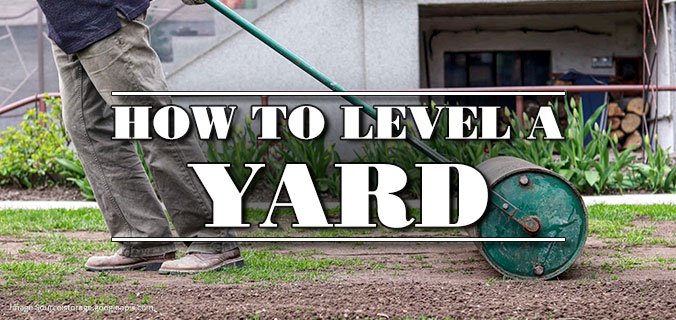A level yard doesn’t only have aesthetic appeal. There are several reasons why keeping the yard level will lead to a healthier yard overall. When you are on a quest for the best-manicured yard on your block, you don’t have time for an unlevel lawn. From large slopes to divots in the soil caused by weeds and critters, there are so many ways that your grass can take on a poorly leveled look. You want to balance your backyard, but you don’t know where to start, and the cost of leveling by a professional seems too steep. With the steps you read in this article, you will know what you need to become a backyard professional when leveling your yard.
Why Is It Important to Have a Level Lawn?
A level lawn doesn’t only have aesthetical appeal; there are several reasons why keeping the ground even will lead to a healthier yard overall. The most important aspect from a visual and health angle for your grass is having an even cut. A level yard prevents your mower from bouncing around during the process, which maintains an even cut throughout, preventing you from cutting the grass too short and potentially harming it.
Filling in those dugout spots in your topsoil also prevents water from pooling in them. Without proper drainage, these holes can pool water, which creates harmful grass conditions.
What Causes a Lawn to Be Bumpy?
Before you do anything to correct the problem, it is important to understand why your yard is uneven in the first place. If you don’t fix the source of the problem, it will inevitably continue to happen.
One culprit that is bigger than leveling is water damage – this can be due to poor soil drainage, but the problem may be more severe than that. If you see multiple slopes in your yard, there could be a plumbing issue underground. A broken pipe or other water pooling issues could lead to a sinkhole, so it is best to deal with an issue like that as soon as possible.
Another common problem that you can’t really avoid is dirt settling. This is more common with new versus established lawns as the soil relaxes. If you live in a place where the weather can vary greatly depending on the season, you may also see a fair amount of ground settling. Not only does the ground expand and contract with the temperature, but sand or clay areas will thaw unevenly, forcing the ground to move.
The last big problem that homeowners will face is pests. There is a wide range of lawn pests, from microscopic bugs to ants and wasps digging holes to larger mammals like rabbits and moles wreaking underground havoc. You will want to remove or repel these animals from your yard humanely before fixing the problem, as they will keep coming back to undo the work you’ve done.
What Equipment Will I Need?
The good news is that most households with yards will already have most of the tools you need to level a lawn. Tools you’ll need include typical yard work tools like a rake, a shovel, and a push broom. Some less standard tools that you’ll need will include a wheelbarrow and an edger. The one tool most people will have to buy is a dedicated lawn leveling rake. A leveling rake is specifically made to distribute soil evenly while removing debris that would cause bumps like wood or rocks. In severe cases, you may need a transit level, but that won’t be the case for most people.
How to Level a Bumpy Lawn
The steps it takes to level a yard really depend on the shape it’s in. Most lawns need a simple redo of the top dressings, but a more drastic approach is needed in some instances. Let’s start with the worst-case scenario and work our way down to where you’re probably going to be.
Regrading the Yard
For most people, this is not going to be necessary, and it may be worth hiring a professional if things are this bad, but there are no rules that say you can’t do it yourself.
- Check with the city to ensure there are no rules that say you can’t do it yourself and obtain the proper permits needed.
- Use a transit level to measure the slope line for proper drainage.
- Remove the topsoil from the areas you are regrading.
- Level out the subsoil by flattening high areas and filling in low places.
- Add two inches of topsoil, then till it into the subsoil to mix the two – this will help prevent drainage issues in the future.
- Add the rest of your topsoil and level it with the surrounding dirt.
- Add sod or plant grass seed and wait.
Leveling Small, Deep Patches
If your yard is in pretty good condition, but there are a few noticeable deep patches, you can usually fix those quickly in a day.
- Carefully remove the sod from the area by cutting it into strips and rolling it up to be reused.
- Add topsoil to the hole – when you are doing this, air pockets will form in the topsoil, add water to remove those pockets; otherwise, they will eventually pop, and your grass will settle lower in that spot.
- Level your topsoil with the surrounding dirt.
- Roll your sod back over the patch and water it.
Top Dressing
This will be the most common way to level a yard – It is the easiest way to address an uneven, bumpy lawn.
- Mow the grass as short as possible.
- Use your rake to dethatch the grass.
- Use a shovel to scoop topsoil or a leveling mix on uneven areas of the soil.
- Use a push broom or a leveling rake if you have one to spread the soil over the grass, allowing it to work into any uneven holes. Most of the soil should find a home in a hole, and you shouldn’t see a lot of it in or on the grass.
- Water the grass and wait a few days.
- Recheck the area and if there are still divots in the soil, repeat these steps.
What About Small Mounds?
If you have a small mound likely caused by an animal, you may be able to flatten it without much work. The trick is to wait until the spring when the ground is soft and then step on the mound to flatten it. You could also use a roller or tamper, but be careful not to press down too hard, or you’ll compact the ground, which could lead to unevenness later on.
Related Questions
How Much Does it Cost to Level a Hill?
Sometimes the job is better left to professionals, as is the gas with large slopes. If you have a hill on your property, it will take heavy equipment and professional know-how to level it out. There is no set cost because it depends on the slope’s size and grade, but it averages between $1 and $15 per cubic yard.
What is the Best Top Dressing?
There are two common top dressings used depending on your geographic area and the time you are willing to put into your top dressing. Many people use sand by itself because it can be used out of the bag, making it a quick and easy solution. The other option is a sand-soil mix, which is better for the grass and can come pre-mixed, or you can mix it yourself to find a composition that you prefer.
Is Landscaping Hard
Landscaping is all about patience, and it can be a time-consuming endeavor with many steps, but most people can do it. Some people even find landscaping relaxing and do it as a hobby. As far as home-owning chores go, landscaping is one of the better do it yourself tasks.




Comments are closed.